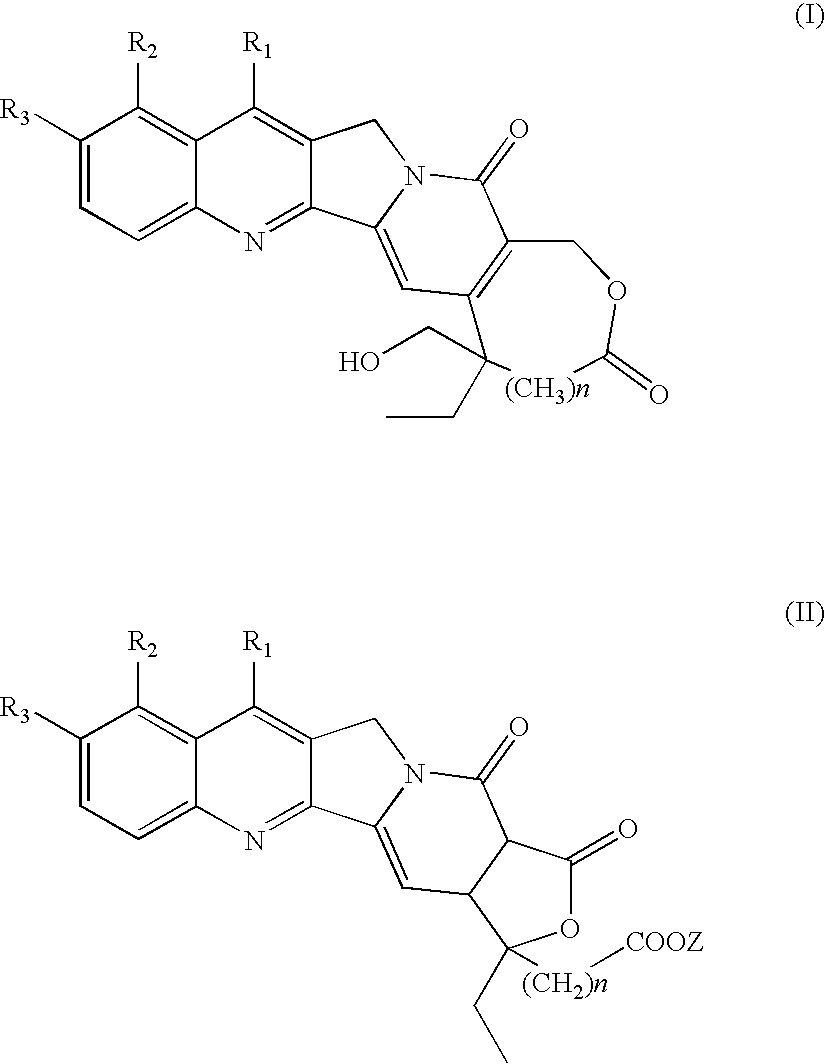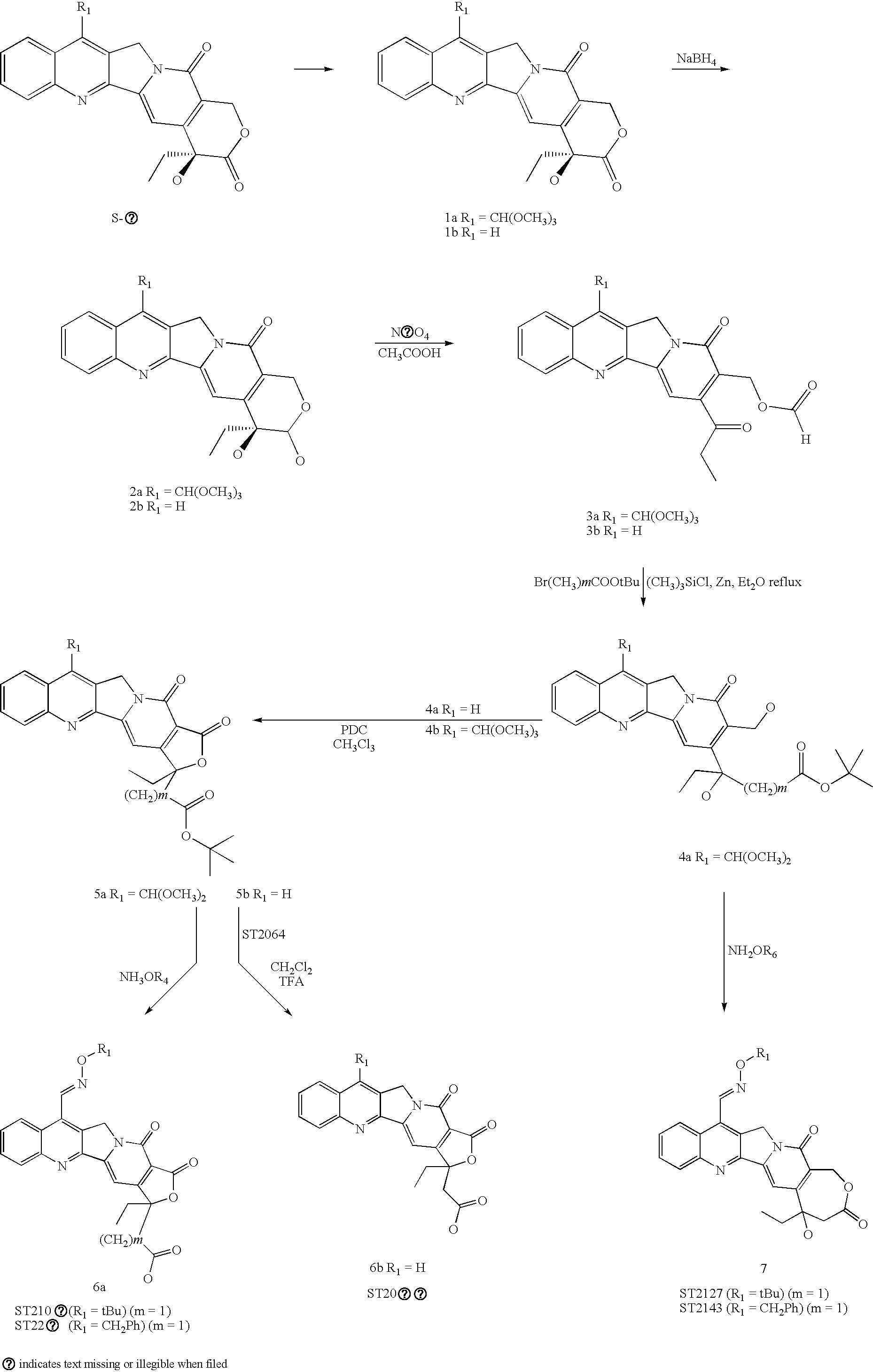Camptothecins with a modified lactone ring
a technology of lactone ring and camptothecin, which is applied in the direction of antiparasitic agents, biocide, drug compositions, etc., can solve the problem that no experimental evidence is provided that the technical problem has been solved, and achieves better therapeutic index, stable plasma, and substantial anticancer activity.
- Summary
- Abstract
- Description
- Claims
- Application Information
AI Technical Summary
Benefits of technology
Problems solved by technology
Method used
Image
Examples
preparation 1
Synthesis of 7-(dimethoxymethyl)camptothecin (ST2337)
[0094] To a suspension of 1.53 g (4.4 mmol) of camptothecin in 92 ml of methanol, cooled with an ice bath under stirring, were added slowly 9.2 ml of H2SO4 96%, keeping the temperature of the mixture below 50° C. The suspension thus obtained was heated to reflux temperature; on reaching 50° C., 46 mg of FeSO4.7.H2O were added and then 3 ml of H2O2 30% dropwise, keeping the reaction at reflux temperature. The reaction was stirred for 2 hours, checking for disappearance of the starting product by TLC. On completion of the reaction, the suspension was cooled to 25° C. and 2.8 ml of MnO2 were added; the mixture was stirred for 2 hours, checking for disappearance of the intermediate product by TLC. The suspension was then filtered through a layer of Celite placed on a Gooch filter. The filtered solution was concentrated to 25 ml and then poured into a solution of NaHCO3 in water so as to obtain a solution at pH 6. The precipitate was...
preparation 2
Synthesis of Intermediate Product 2a
[0096] To a solution of 2.12 g (56 mmol, 3.3 eq) of NaBH4 in 70 mL of MeOH were added 7.2 g (17 mmol) of 7-dimethyl-acetal camptothecin (a); the mixture thus obtained was stirred at room temperature for 1 h. At the end of this operation acetone was added to destroy the NaBH4 in excess and the solution was brought to dryness. The crude reaction product was purified by flash chromatography on silica gel (eluent gradient CH2Cl2 / MeOH 92 / 8 CH2Cl2 / MeOH 7 / 3) to yield 3.7 g (8.7 mmol, 51%) of product as a yellow solid.
C23H24N2O6 (424.5); Rf=0.41 (1st isomer), 0.35 (2nd isomer) (CH2Cl2 / MeOH 92 / 8).
MS (IS): [MH]+=425; [M+Na]+=447; [M−1]=423.
Elemental analysis: calculated: C, 65.09; H, 5.66; N, 6.60; found C, 65.12; H, 5.68; N, 6.57.
[0097]1H NMR (DMSO-d6) δ=0.84-0.90 (t, 3H, CH3), 1.65-1.73 (m, 2H, CH2), 3.38 (s, 6H, CH3), 4.43-(4.50-4.57) 4.64 (dd, 2H, CH2), 4.98 (s, 1H, CH), 5.28 (s, 2H, CH2), 6.32 (s, 1H, CH), 7.38 (s, 1H, CH), 7.66-7.73 (t, 1H, C...
preparation 3
Synthesis of Intermediate Product 3a
[0098] To a solution of 5.52 g (13 mmol) of 2a in 100 ml of CH3COOH were added 4.17 g of NaIO4 (19.5 mmol, 1.5 eq.). The mixture was stirred at room temperature for 16 h; at the end of this operation, the solution was concentrated and diluted with CH2Cl2, then extracted with NaHCO3 to neutral pH. The organic phase was dried on Na2SO4 and evaporated to dryness. Purification was performed by flash chromatography on silica gel (eluents: CH2Cl2 / MeOH 98 / 2). 3.58 g (8.48 mmol, 65%) of product were obtained as a yellow solid.
C23H22N2O6 (422.4); m.p. (decomp.)=150° C.;
[0099] Rf=0.6 (CH2Cl2 / MeOH 95 / 5).
Elemental analysis: calculated: C, 65.40; H, 5.21; N, 6.64; found C, 65.39; H, 5.23; N, 6.61.
MS (IS): [MH+=423; M+Na]+=445.
1H NMR (DMSO-d6) δ=1.07-1.2 (t, 3H, CH3), 2.96-3.3 (m, 2H, CH2), 3.37 (s, 6H, CH3), 5.12 (s, 2H, CH2), 5.18 (s, 2H, CH2), 6.37 (s, 1H, CH), 7.38 (s, 1H, CH), 7.73-7.79 (t, 1H, CHAr), 7.86-7.92 (t, 1H, CHAr), 8.16-8.20 (d, 1H, CH...
PUM
 Login to View More
Login to View More Abstract
Description
Claims
Application Information
 Login to View More
Login to View More - R&D
- Intellectual Property
- Life Sciences
- Materials
- Tech Scout
- Unparalleled Data Quality
- Higher Quality Content
- 60% Fewer Hallucinations
Browse by: Latest US Patents, China's latest patents, Technical Efficacy Thesaurus, Application Domain, Technology Topic, Popular Technical Reports.
© 2025 PatSnap. All rights reserved.Legal|Privacy policy|Modern Slavery Act Transparency Statement|Sitemap|About US| Contact US: help@patsnap.com



